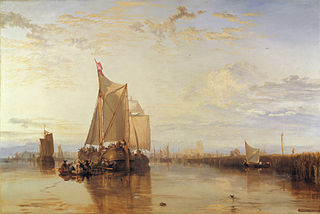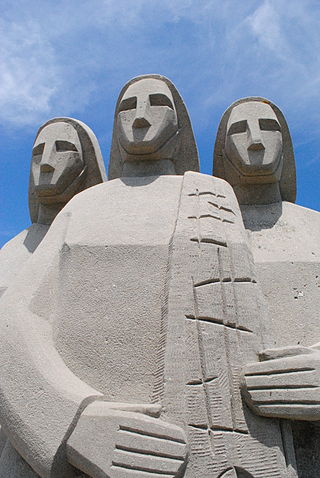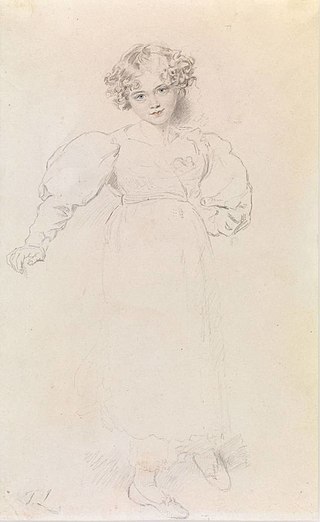
Joseph Mallord William Turner, known in his time as William Turner, was an English Romantic painter, printmaker and watercolourist. He is known for his expressive colouring, imaginative landscapes and turbulent, often violent marine paintings. He left behind more than 550 oil paintings, 2,000 watercolours, and 30,000 works on paper. He was championed by the leading English art critic John Ruskin from 1840, and is today regarded as having elevated landscape painting to an eminence rivalling history painting.

Samuel Prout was a British watercolourist, and one of the masters of watercolour architectural painting. Prout secured the position of Painter in Water-Colours in Ordinary to King George IV in 1829 and afterwards to Queen Victoria. John Ruskin, whose work often emulated Prout's, wrote in 1844, "Sometimes I tire of Turner, but never of Prout". Prout is often compared to his contemporaries: Turner, Constable and Ruskin, whom he taught. He was the uncle of the artist John Skinner Prout.

Mary Frances Pratt, LL. D. D.Litt. was a Canadian painter known for photo-realist still life paintings. Pratt never thought of her work as being focused on one subject matter: her early work is often of domestic scenes, while later work may have a darker undertone, with people as the central subject matter. She painted what appealed to her, being emotionally connected to her subject. Pratt often spoke of conveying the sensuality of light in her paintings, and of the "erotic charge" her chosen subjects possessed.

The Beaverbrook Art Gallery is a public art gallery in Fredericton, New Brunswick, Canada. It is named after William Maxwell "Max" Aitken, Lord Beaverbrook, who funded the building of the gallery and assembled the original collection. It opened in 1959 with over 300 works, including paintings by J. M. W. Turner and Salvador Dalí. The Beaverbrook Art Gallery is New Brunswick's officially designated provincial art gallery.

The Beacon Light is a painting by J. M. W. Turner. It was given to the National Museum of Wales by the Davies sisters. For some time it was regarded as a fake, but is now accepted as authentic.
Jay Isaac is a Canadian artist based in Rowley, New Brunswick, Canada. He is known primarily for his painting, but he has produced numerous projects within the social sphere. He was founder, editor, publisher, and designer of Hunter and Cook magazine (2009-2011). He founded and ran the @nationalgalleryofcanada Instagram account (2014-2016). He founded and co-runs Peter Estey Fine Art, an auction house dedicated to presenting idiosyncratic historical Canadian art (2018–present). Isaac is represented by Paul Petro Contemporary Art in Toronto.
Janice Wright Cheney is a Canadian visual artist based in Fredericton, New Brunswick.

Musidora: The Bather 'At the Doubtful Breeze Alarmed', also known as The Bather, is a name given to four nearly identical oil paintings on canvas by English artist William Etty. The paintings illustrate a scene from James Thomson's 1727 poem Summer in which a young man accidentally sees a young woman bathing naked, and is torn between his desire to look and his knowledge that he ought to look away. The scene was popular with English artists as it was one of the few legitimate pretexts to paint nudes at a time when the display and distribution of nude imagery was suppressed.

The Dort, or Dort or Dordrecht: The Dort packet-boat from Rotterdam becalmed is an 1818 painting by J. M. W. Turner, based on drawings made by him in mid September 1817. It shows a view of the harbour of Dordrecht. It is the finest example of the influence of Dutch marine painting on Turner's work.
Martin Richard Fletcher Butlin, CBE, FBA, is a British art historian. His main field of study is British art history and his published works reflect, in particular, a study of art of the 18th and 19th centuries. He is an authority on J.M.W. Turner (1775–1851) and William Blake (1757–1827).

Claude Roussel is a Canadian sculptor, painter and educator.

In 1842, British artist J. M. W. Turner painted three watercolours of the Rigi, a mountain in the Alps in Central Switzerland, which he had visited the previous summer. Widely regarded as some of his finest works, the watercolours capture the transitory effects of light and atmospheric conditions at the Rigi. According to John Ruskin, "Turner had never made any drawings [watercolours] like these before, and never made any like them again ... He is not showing his hand in these, but his heart."

Fishermen at Sea, sometimes known as the Cholmeley Sea Piece, is an early oil painting by English artist J. M. W. Turner. It was exhibited at the Royal Academy in 1796 and has been owned by the Tate Gallery since 1972. It was the first oil painting by Turner to be exhibited at the Royal Academy. It was praised by contemporary critics and burnished Turner's reputation, both as an oil painter and as a painter of maritime scenes.

Anna Torma is a Hungarian-Canadian fibre artist.

John Allnutt (1773–1863), was a British wine merchant and art collector. Alnutt was a patron of John Constable, J. M. W. Turner and Thomas Lawrence.
Frederick Joseph Ross LL. D. was a Canadian artist best known for his figurative drawings, paintings and murals.

The Golden Bough is a painting from 1834 by the English painter J. M. W. Turner. It depicts the episode of the golden bough from the Aeneid by Virgil. It is in the collection of the Tate galleries.
Michael Adamson is a Canadian painter, known for a style that blends landscape with abstraction.
Herzl Kashetsky LL. D. is a realist painter, known for his commemorative work in paintings dedicated to victims of the Holocaust. The main body of his art has been figurative, and embedded in the representational.
Thomas DeVany Forrestall is a Canadian realist painter. Forrestall was born in Middleton, Nova Scotia and studied with Alex Colville at Mount Allison University. He has been a fulltime professional artist since 1960. His works, chiefly painted in watercolour or egg tempera, are held by major galleries throughout Canada.












